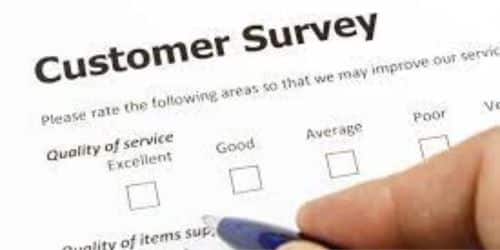Customer satisfaction surveys are a useful tool for obtaining feedback. It won’t, however, help you improve your customer experience if you periodically send out a random collection of survey questions about customer happiness. Create surveys with a purpose in mind and carefully construct questions that help you gather pertinent information to get meaningful feedback. In this post, we will be looking into the explanation of customer surveys and some examples to use for rating your customers.
Customer Surveys
The kind of experience you provide to your customers determines the marketability and worth of your product or service. Good customer service is therefore essential to a company’s success. No matter how excellent your product or service is, one negative client experience could result in a permanent loss of customers.
More than 96% of consumers agree that customer service influences brand choice and loyalty. To improve customer experience, measuring customer service performance is becoming more and more crucial for many firms. Customer service surveys are useful in this situation. They enable you to identify gaps in your procedures by asking the clients directly by recording customer feedback.
Giving customers satisfying experiences starts from the minute they arrive on your website and continues well after they become paying clients. Most organizations make the error of spending more effort into attracting new clients and fostering customer loyalty than they do in enhancing the experiences of current ones.
Customer Service Surveys’ Importance
A company looking to attract customers and maintain its growth can gain a lot from conducting customer service surveys. Here are a few ways that evaluating customer service metrics can help you improve your company:
#1. Reduced Churn Rate
You may monitor the effectiveness of your customer service operations as well as the performance of your agents by regularly conducting customer service surveys. It can help you provide your consumers with better services or products, respond to their inquiries more swiftly, and raise their level of satisfaction with your company as a whole.
#2. Determine Areas for Development
Customer satisfaction surveys Your workflow performance might reveal the areas and procedures that want improvement.
#3. More Referrals
When you successfully provide a consumer with exceptional customer service, they will remember you. Gaining consumers’ loyalty can be achieved in large part by listening to their feedback, acting on it, and keeping them informed. Customers that are loyal to your company are more likely to recommend it to their friends, coworkers, or family.
#4. Establish Strict Criteria for Customer Service
You can monitor your customers’ happiness with your services and products as well as the performance of your agents by conducting customer service surveys. By consistently doing this, your business is able to maintain high standards for customer service and maximize client happiness.
Customer Satisfaction Survey Types
What are the many customer satisfaction survey formats available?
#1. Customer Satisfaction (CSAT) Score Survey
Customers’ levels of satisfaction with a company’s products and services are gauged through the Customer Satisfaction (CSAT) Score survey. A survey normally uses a scale of 1 to 5 to gauge how satisfied a customer is. “How would you rate your overall satisfaction with our company or business?” is the typical inquiry. The CSAT method, one of the most well-known and frequently employed types of customer satisfaction surveys, enables businesses to monitor consumer satisfaction with their goods and services using a single number.
#2. Net Promoter Score (NPS) Survey
Many businesses employ the Net Promoter Score (NPS) survey as a tool to gauge client loyalty. This style of customer satisfaction survey was first popularized by Frederick Reichheld in his 2003 article for the Harvard Business Review. It consists of one key inquiry: “On a scale of 0 to 10, how likely is it that you would recommend our company, product, or service to a friend or colleague?” You’ll be able to rapidly divide your clients into Promoters, Passives, and Detractors based on how they answered the question.
#3. Customer Effort Score (CES) Survey
The Customer Effort Score (CES) survey calculates the level of effort customers have expended during their interactions or experiences with your business. The questions are typically stated as “Did the company make it easy for you to handle your issue?,” or “How much effort did you have to make for your issue to be resolved?”
The CES methodology, one of the most commonly used kinds of customer satisfaction surveys, typically gives respondents a choice between a 5- or 7-point scale. Simply averaging the responses gathered yields scores.
#4. Surveys Designed for Online Reviews
One meant to assist businesses in generating much-needed social proof through internet evaluations is another form of customer satisfaction survey that is becoming more and more prevalent. These are often disseminated through the media types that have the highest response rates from customers: SMS, email, business review websites, and specially branded landing pages. Frequently, the poll has links to the profiles on a company’s review websites, making it simple for respondents to provide feedback and submit reviews.
Examples of Customer Surveys
No single customer satisfaction survey template can provide you with all the information you need to enhance CX. Instead, make survey questions specific to the needs of various departments and customer touchpoints. Use the following collection examples of use case-specific customer satisfaction surveys questions.
#1. Demographic Questions
Marketing and sales can split customers into buyer personas by asking questions that gauge your client demographics. Responses may reveal incredibly insightful information that affects revenue and support strategy. Questions about demographics can both confirm already-existing patterns and reveal new ones. Some examples of demographic inquiries are:
- How many people work for your company?
- What is your age?
- Whereabouts are you?
#2. Product Usage Questions
Your business can better understand the customer experience by asking survey questions about how customers utilize your product or service. To learn what needs to be improved to maintain your audience’s loyalty, ask customers what they like and don’t like about your service. Examples of inquiries regarding product usage include:
- What do you think of your purchase?
- Would you tell a friend to use our product or service?
#3. Quantitative Customer Feedback Questions
While qualitative reactions are crucial, numbers are more straightforward to quantify. These survey questions can assist you in validating, confirming, or refuting issues so that you can act on the information you get. Quantitative customer feedback examples include the following:
- What do you think of this interaction?
- Please assign a star rating out of five to your customer support person.
- How pleased were you with the support agent’s interaction?
#4. Follow-up Questions
Make sure you’ve covered all your bases by asking follow-up inquiries. Customers’ opinions of recent interactions with your company should be sought out. When a consumer has completed a transaction or gotten in touch with customer service, you can send follow-up questions. Examples of follow-up inquiries are as follows:
- We appreciate you contacting us and sharing your thoughts with our customer support team. How can we make our assistance options better?
- We are getting in touch with customers who have recently made a transaction. Could you elaborate more about your experience?
#5. Open-Ended and Long-Form Questions
Customer satisfaction surveys with open-ended questions enable respondents to express their thoughts and experiences in greater detail. You may improve your products, expand your knowledge base, and identify problem areas with the use of descriptive responses.
Open-ended and extended queries include the following:
- Using our product, how would you characterize your experience?
- What aspect of the product doesn’t function for you and why?
- How can we make your interaction with our brand better?
#6. Ordinal Scale Questions
Ordinary inquiries use a list of ordered responses to gauge the feelings or opinions of customers. Each response is positioned in a particular order so that it is more or smaller than the others. Questions using an ordinal scale include the following:
- How happy are you with the customer service we provide?
- How likely are you to tell a friend or work colleague about [Product or Service Name]?
- How significant is [feature] while buying ?
#7. B2B Questions
Other business professionals are the primary target of B2B survey questions. B2B surveys are frequently used to determine consumer interest in a service or product to boost sales. The answers to these questions can be used to fix issues or enhance services. Typically, you will adjust these questions based on the industry, job title, and size of the organization. Examples of B2B inquiries include as follows:
- In what ways are you pleased to work with [Company Name]?
- To what extent did [Company Name] adhere to the project schedule?
- How pleased are you with our pricing strategies?
#8. B2C questions
Because you focus on the general public or customers rather than other business experts, B2C survey questions are different from B2B survey questions. These inquiries typically center on a customer’s interaction with the good or service. Examples of B2C inquiries are:
- How would you rate your experience staying at our hotel?
- How would you rate the service you received during your most recent visit?
- Would you tell your family or friends about our services?
Questions for Customer Surveys
There are questions for proper customer surveys, and they differ in their separate approach. Lets look at them and what they stands for:
#1. Were You Able to Find the Information You Were Looking For on Our Website?
This question may be used to monitor customer service performance and the efficiency with which problems are resolved, therefore including it in your customer service surveys goes beyond simple courtesy. The likelihood that clients will return to your website increases dramatically if they are able to find what they were looking for there.
Another important question to ask your clients is whether or not they find it easy to navigate your website. It becomes even more crucial to inquire about any recent website updates. What better method to find out how to make your website as user-friendly as possible than to ask the users themselves?
#3. How Much Work Did You Put into Finding the Answer to Your Question?
Customer service surveys can be used to measure the amount of effort customers make to have their issues fixed. They will be more satisfied with your business if they put forth less effort. In reality, when clients exert less effort, it shows that your procedures are efficient and that they can get timely service. It might eventually cause the retention rate to rise.
#4. How Responsive Have We Been in Answering Your Concerns Regarding Our Product?
This inquiry is frequently made right away following a client engagement with your customer service team. By posing this query, you demonstrate your concern for and appreciation of your consumers’ feedback and opinions. You can evaluate several aspects of your business with questions like these. You can assess the efficiency of your good or service, identify problems that are more difficult to resolve, ascertain whether customer care representatives have received the necessary training to deal with client inquiries, and so forth.
What Is Customer Survey Method?
Consumer input is gathered through customer questionnaires. They aid businesses in doing market research, measuring customer engagement, determining expectations, and gauging customer satisfaction.
What Are the 7 Different Ways to Measure Customer Satisfaction?
7 ways to gauge client pleasure:
- Make a plan.
- Create efficient surveys.
- Software for measuring CX should be chosen.
- Gather and analyze the data.
- Gather, do, then repeat.
- Online questionnaires.
- Using social media.
- A live chat.
Related Posts
- CUSTOMER FEEDBACK: The Only Guide You Will Ever Need
- How Customer Support Can Increase Customer Satisfaction
- CUSTOMER SATISFACTION: Ways to Boost Customer Satisfaction






